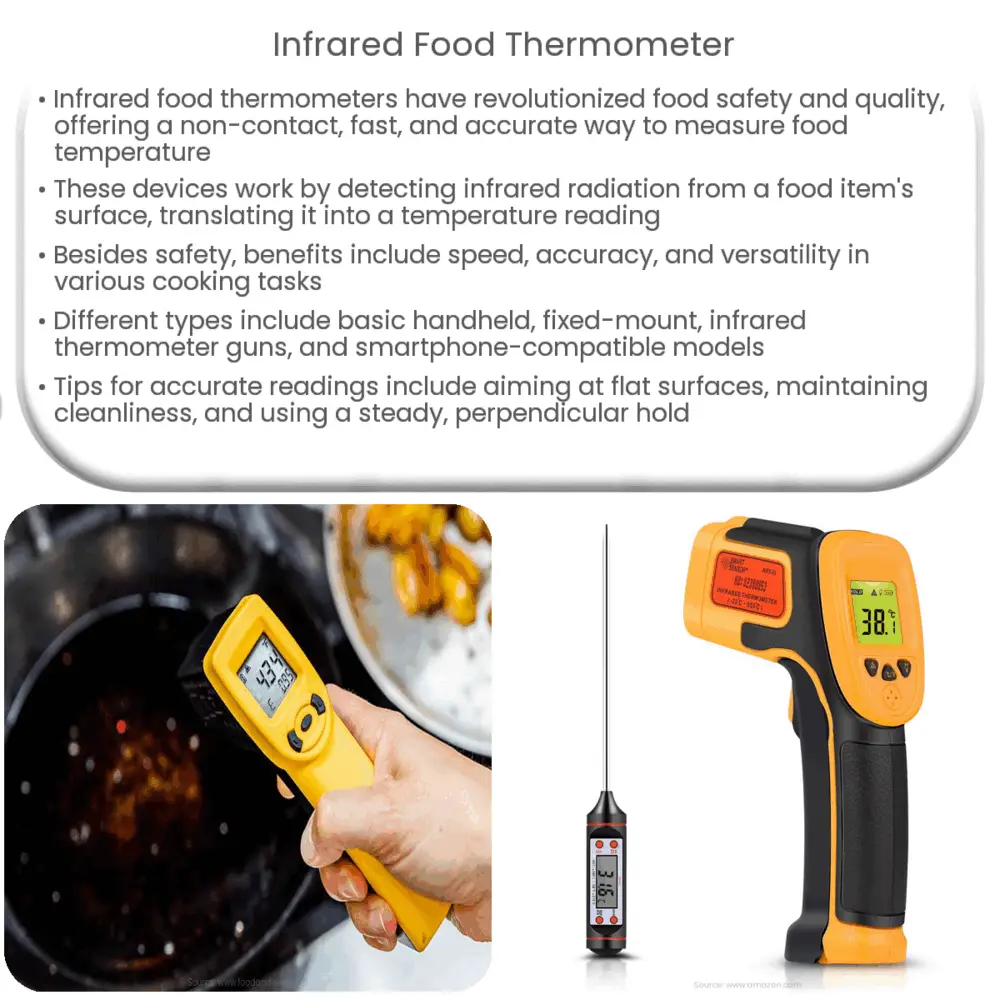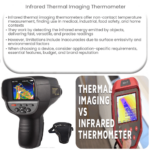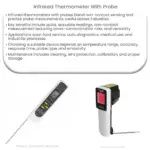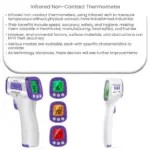Explore the benefits of infrared food thermometers, learn about different types, and get tips on choosing and using them effectively.

Infrared Food Thermometer: Revolutionizing Food Safety and Quality
Introduction
In recent years, the infrared food thermometer has become an increasingly popular tool for both professional chefs and home cooks. This innovative device offers a safe, efficient, and accurate method for measuring the temperature of various food items, ensuring that they are cooked to perfection and safe to consume. In this article, we will explore the basics of infrared thermometers, their advantages, and how they are revolutionizing food safety and quality in the culinary world.
What is an Infrared Food Thermometer?
An infrared food thermometer, also known as a non-contact or laser thermometer, is a device that measures the temperature of a surface without making physical contact with it. It does this by detecting the infrared energy emitted by an object and converting that energy into a temperature reading. Infrared thermometers have a variety of applications, including automotive diagnostics, industrial maintenance, and, of course, food safety and quality control.
How Does an Infrared Food Thermometer Work?
The infrared food thermometer works on the principle of infrared radiation. All objects emit infrared radiation, and the amount of radiation emitted is proportional to the object’s temperature. When the thermometer is pointed at a food item, it detects the infrared radiation emitted from its surface and calculates the temperature based on that data.
Most infrared thermometers feature a laser pointer, which helps to ensure that the user is accurately targeting the surface to be measured. Once the trigger is pressed, the thermometer takes a temperature reading in just a few seconds, providing a quick and easy way to check the temperature of your food.
Advantages of Using an Infrared Food Thermometer
Infrared food thermometers offer a number of advantages over traditional contact-based thermometers. Some of the key benefits include:
- Non-contact measurement: Since infrared thermometers do not need to touch the surface they are measuring, they eliminate the risk of cross-contamination, ensuring a safer and more hygienic cooking environment.
- Speed: Infrared thermometers provide near-instantaneous temperature readings, allowing you to quickly check multiple food items without wasting time. This is especially useful when cooking large quantities of food or when working in a fast-paced professional kitchen.
- Accuracy: Infrared thermometers are highly accurate, providing temperature readings that are often within ±1°C or ±2°F of the actual temperature. This level of accuracy ensures that your food is cooked to the desired level of doneness and is safe to eat.
- Versatility: With the ability to measure the temperature of a wide range of surfaces, infrared thermometers are suitable for various cooking tasks, from checking the temperature of frying oil to monitoring the internal temperature of meat.
In the second part of this article, we will discuss the different types of infrared food thermometers, how to choose the right one for your needs, and tips for using them effectively in your kitchen. Stay tuned!
Types of Infrared Food Thermometers
There are several types of infrared food thermometers available on the market, each designed to cater to specific needs and preferences. Some of the most common types include:
- Basic handheld infrared thermometers: These are the most common and affordable infrared thermometers. They are compact, easy to use, and ideal for home cooks and professionals alike.
- Fixed-mount infrared thermometers: These thermometers are designed to be mounted in a stationary position, providing continuous temperature monitoring for applications such as deep-frying, candy making, or sous vide cooking.
- Infrared thermometer guns: These thermometers have a pistol-like design and offer a longer range of temperature detection. They are ideal for measuring the temperature of hot surfaces or objects that are difficult to access.
- Smartphone-compatible infrared thermometers: These thermometers connect to your smartphone via Bluetooth or Wi-Fi, allowing you to monitor and track temperature readings through a dedicated app. This feature is particularly useful for remote temperature monitoring and recording.
Choosing the Right Infrared Food Thermometer
When selecting an infrared food thermometer, consider the following factors to ensure you choose the right device for your needs:
- Temperature range: Choose a thermometer with a temperature range that covers the temperatures you typically work with in your cooking. Most infrared thermometers have a range between -50°C and 500°C (-58°F and 932°F), which is sufficient for most culinary applications.
- Accuracy: Look for a thermometer with an accuracy of at least ±1°C or ±2°F to ensure precise temperature readings.
- Distance-to-spot ratio (D:S): The D:S ratio indicates the size of the area being measured in relation to the distance from the thermometer. A higher D:S ratio provides more accurate temperature readings from a greater distance. A ratio of 12:1 is generally considered suitable for most cooking tasks.
- Emissivity: Emissivity is the measure of an object’s ability to emit infrared radiation. Some infrared thermometers have adjustable emissivity settings, allowing you to measure the temperature of different types of surfaces more accurately. Consider a thermometer with adjustable emissivity if you plan to use it on various food items and surfaces.
- Additional features: Consider additional features such as a backlit display, temperature alarms, and data logging capabilities based on your specific needs and preferences.
Tips for Using an Infrared Food Thermometer Effectively
To ensure accurate and consistent results when using an infrared food thermometer, follow these tips:
- Always aim the thermometer at a flat, non-reflective surface for the most accurate readings.
- Keep the thermometer clean and free of dust, dirt, and grease, as these can affect the accuracy of the temperature readings.
- Hold the thermometer steady and at a perpendicular angle to the surface being measured.
- Be aware that infrared thermometers measure surface temperature, not internal temperature. Use a probe thermometer for measuring the internal temperature of meat and other foods.
- Consult the user manual for specific guidelines on using your infrared food thermometer, as different models may have unique features or instructions.




